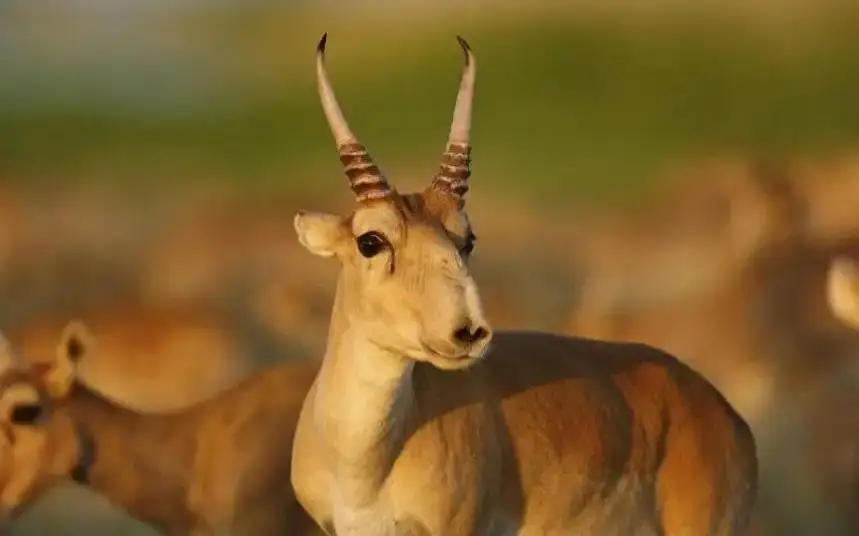Saigas vs. Farmers: Battle for Pastures

The annual increase in the number of saigas has become a complex problem in the West Kazakhstan region. What impact do these animals have on the environment? Is compensation provided for farmers who have suffered losses from saigas? A correspondent from the Kazinform agency turned to experts to find answers to these questions.
Do wild animals transmit infectious diseases?
According to the director of the Research Institute of Veterinary Science and Biotechnology of the West Kazakhstan Innovation and Technological University, Doctor of Veterinary Sciences, Professor Gaisa Absatirov, the excessive growth of the Ural saiga population is the cause of a shortage of feed and watering places for livestock, creating difficulties for agricultural producers in the regions and owners of private farms.
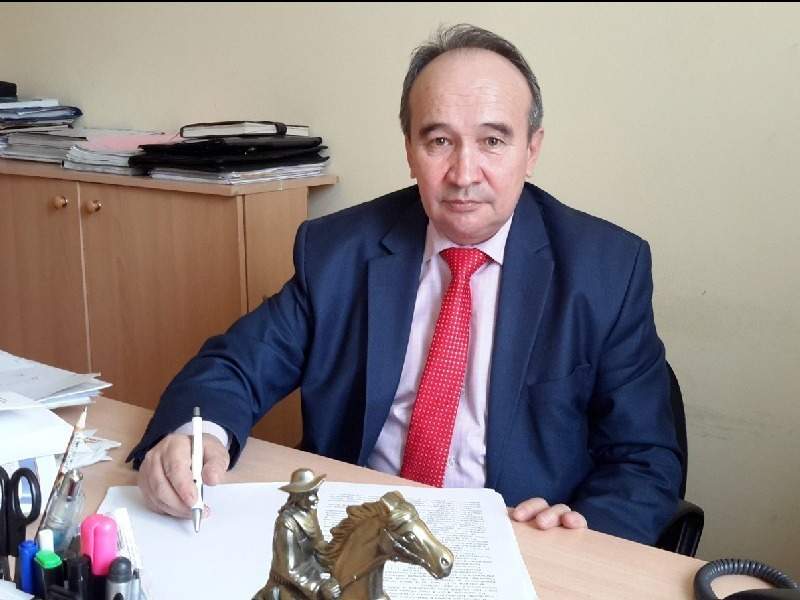
According to the scientist, this is due to the fact that the Zhanakalinsky, Bokeyordinsky, Zhanibeksky and Kaztalovsky districts in the south of the region are engaged in the development of livestock farming. The increase in the number of livestock, on the one hand, and saigas, on the other, leads to disruption of the ecosystem. In these districts, there is already a shortage of pastures and hayfields.
— Saigas are naturally very cautious animals, it was previously impossible to approach them. But now this is history. Due to the excessive increase in the number of saigas, changes have occurred in ethology (the science that studies the biological basis of animal behavior). In particular, saigas have lost their fear, they freely roam near populated areas and farms at any time, and graze together with cattle. Considering that the region is not in a very favorable situation from a veterinary point of view, the risk of spreading diseases from sick and dead saigas increases, — the scientist says.
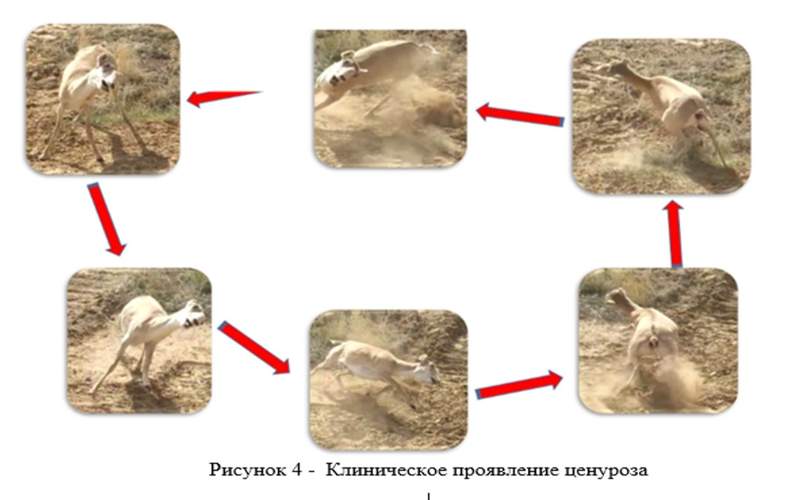
As studies have shown, excessive growth of the saiga population leads to infection not only among themselves, but also to cattle and even people. A significant part of the saigas can die from diseases. In addition, they can also become infected from sick cattle. Currently, the Ural population of saigas has exceeded 3 million heads. The close proximity of saigas to cattle, stray dogs and other animals contributes to the spread of various diseases. This is proven by photographs and videos sent by farmers and residents.
In recent years, ticks, which can spread various diseases, have become a scourge for both domestic and wild animals. Residents, as well as some experts and bloggers, associate their spread with saigas. This is not true.
Ticks can be called one of the members of the ecosystem. They survive the winter in the soil, in the roots of bushes, rodent holes, livestock buildings, animal feces, and in the spring they begin to attack animals. Ticks are also found in other regions of Kazakhstan where saigas live. There are methods to combat them, and chemicals are available in sufficient quantities. Therefore, livestock owners should not blame the saigas, but carry out timely treatment measures.
— The Ministry of Ecology and Natural Resources has decided to preserve the saiga population. That is, work on regulating the saiga population has been suspended until 2029. In this regard, the emphasis is on protecting agricultural lands. And yet, we have not resolved the issue of collecting and disposing of the carcasses of these animals in their habitats, including near populated areas. This is currently being done by the Okhotzooprom Production Association and teams from the Bokeyorda State Nature Reserve. In addition, they do not have veterinary specialists, equipment for autopsy of dead saigas and selection of pathological material for laboratory research. Veterinary services of local executive bodies hide behind the fact that work with wild animals is not within the scope of their activities, and are disengaged, — says Professor G. Absatirov.
Can we benefit from saiga horns?
According to the professor, it should also be noted that more and more saiga corpses are found every year. The issue of effective use of the horns of dead animals needs to be resolved. Currently, all organizations involved in the protection of saigas (Okhotzooprom, Bokeyorda Reserve) are afraid of falling under Article 339 of the Criminal Code of the Republic of Kazakhstan (Illegal handling of rare and endangered species, as well as species of plants or animals prohibited for use, their parts or derivatives). Residents who collect the horns of dead saigas pay millions in fines and are deprived of freedom for several years.
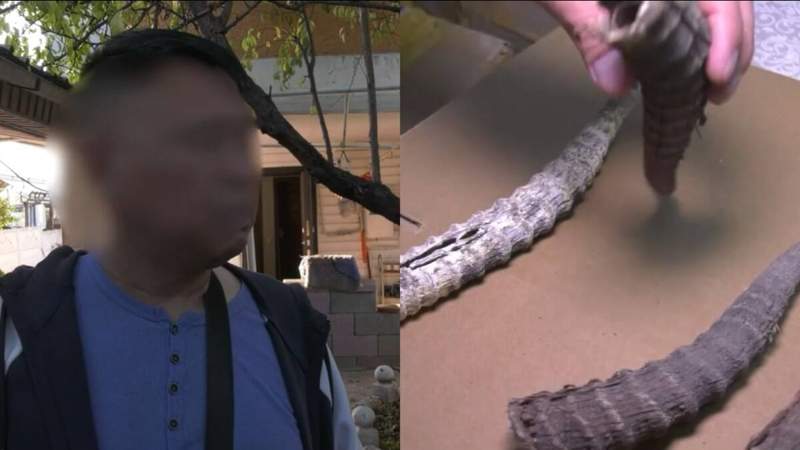
According to members of the working group on regulation of the saiga population, families of offenders suffer from this. In Zhanakala district alone, 54 children are growing up without fathers for this reason.
— Collected saiga carcasses, including males, are destroyed by burning in burial grounds. In our opinion, such destruction of natural wealth is a complete waste. In the end, it is time to review Article 339 of the Criminal Code of the Republic of Kazakhstan. It is necessary to properly organize the collection and storage of horns. It is possible to provide a reward for those who collect horns, and the money received from the sale of horns, to direct to solving the problems of residents and farmers living in the territory where saigas live. It is also necessary to staff the Okhotzooprom and Bokeyorda teams with full-time veterinary specialists, to grant them the appropriate documents to perform pathological autopsies of corpses, collect horns, — G. Absatirov believes.
A farmer from the Zhanibek district, Bauyrzhan Sabanov, reported that compensation is not provided for damage to crops, hayfields and pastures by wild animals, since a method for determining damage has not been developed. He believes that Article 339 of the Criminal Code of the Republic of Kazakhstan should be revised and the collection of saiga carcasses should be properly organized.

— About 400 thousand males die every year. That is their nature. But no one uses the horns. Saiga horns last up to two years. Next year, the number of saigas in the West Kazakhstan region may reach 8 million. Therefore, first of all, it is necessary to develop a method for calculating the damaged lands and pay compensation to the victims. Secondly, farmers should be given subsidies of up to 80% for fencing their land. In return, farmers should be required to sow grass on their lands. Thirdly, if it is possible to regulate the number of saigas by catching them, slaughterhouses and refrigeration plants should be opened in villages. Fourthly, it is necessary to open collection points for dead saigas on the ground, and to organize their storage and processing not in Almaty, but in the region. Fifthly, if investors are found who are ready to open saiga nurseries, this will also not be superfluous. There are such examples. This will not only help preserve saigas, but will also have an economic effect. Jobs may open up, and it will be possible to process meat, skins, and bones. For this, it will be necessary to find implementation mechanisms, said B. Sabanov.
The saiga population in the region should not exceed 500-600 thousand
According to the head of the territorial inspection of forestry and wildlife of the West Kazakhstan region, Nurlan Rakhimzhanov, saigas mainly live in the Kaztalovsky, Zhanibeksky, Bokeyordinsky, Zhanakalinsky, Taskalinsky and Akzhayiksky districts.

According to the inspection, the saiga population is growing steadily. For example, 135 thousand heads were counted in 2018, 217 thousand in 2019, 545 thousand in 2021, 801 thousand in 2022, 1 million 130 thousand in 2023, and 1 million 620 thousand in 2024. Taking into account the offspring of the current year, the number of saigas in the region reaches approximately 2 million 300 thousand heads.
According to the results of the analysis of recent years, in the autumn-winter period, especially when there is a lot of snow, most of the saigas move to the territory of the Bokeyordinsky and Zhanakalinsky districts, as well as to the Atyrau region. They also migrate to the Astrakhan region of the Russian Federation.
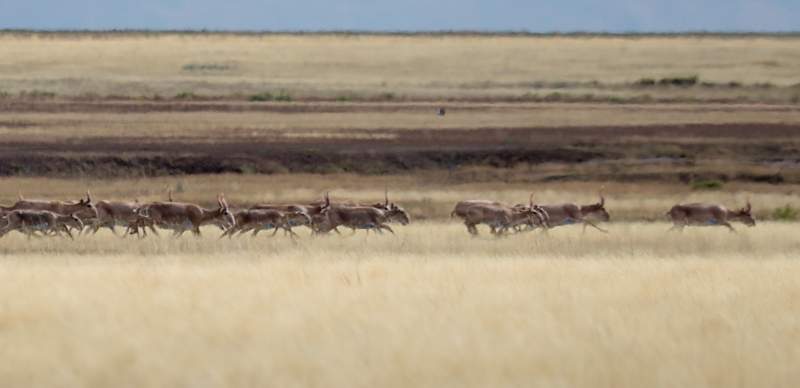
— The growth of the saiga population creates a number of problematic issues in the region. Saiga migrations have no defined boundaries, and they graze and go to water together with livestock. According to the biological justification of WKO scientists, the optimal number of saigas in the region should not exceed 500-550 thousand heads. Due to the lack of land, the simultaneous growth of domestic animals and saigas increases the risk of mutual infection. In addition, great damage is caused to hayfields, pastures and crop lands of peasant farms, — says N. Rakhimzhanov.
The head of the inspection noted that the number of saigas killed by natural causes is growing, and there are no regulations on their destruction. Therefore, the regional akimat developed a “Scheme for interaction between employees of interested state bodies on the destruction of carcasses of wild animals when they are discovered for 2022-2024.”
According to this scheme, the inspector of “Okhotzooprom”, the district inspector and the veterinarian draw up a tripartite act. After that, with the help of the akimat of the rural district, the corpses are delivered to the cattle burial ground and destroyed.
But since the cattle burial grounds are overflowing with corpses, local residents are expressing dissatisfaction on this issue as well. For example, in 2022, 390 corpses were destroyed, in 2023 – 1,336, this year – 5,719.

— Taking this circumstance into account, funds have been allocated for the installation of stationary incinerators in areas where many saigas live. Recently, video and photo materials about the discovery of saiga corpses have often been circulated on social networks. And yet, animal corpses are found in different places, their total number is not registered. In August-September of this year, specialists from the RSE “National Reference Center for Veterinary Medicine” conducted epizootic monitoring in the territory of the West Kazakhstan region. As part of the monitoring, 4 samples were tested for 9 especially dangerous diseases of humans and animals (sheep and goat plague, pasteurellosis, listeriosis, foot-and-mouth disease, tuberculosis, brucellosis, capripox disease, rabies, anthrax) – negative results were obtained. And yet, in connection with the increase in the number of saigas above the optimal level several times, we must take into account that the spread of infectious diseases is quite likely, — says N. Rakhimzhanov.
According to him, 49 Okhotzooprom inspectors, 35 units of motor vehicles and snowmobiles, and 9 mobile groups are involved in saiga protection activities. Since this year, inspectors are involved in protecting crops of peasant farms, these forces are not enough.
For this reason, the issue of increasing the staff of the Ministry of Ecology and Natural Resources of the Republic of Kazakhstan and Okhotzooprom by 112 people and providing them with additional material and technical equipment is being considered.
In addition, if the project to create eco-corridors on the border with Russia is implemented, some saigas will move to the neighboring country and the load on the region will decrease.
According to farmers from the Bokeyordinsky and Zhanibeksky districts, saigas now live not only in Western Kazakhstan, but have also spread to the Balkuduksky and Suyundiksky rural districts of the Kurmangazinsky district of the neighboring Atyrau region and further to the Astrakhan region.
How can we compensate for the damage caused by saigas?
As reported by the employees of the Western regional branch of the State Enterprise “PO Okhotzooprom”, in accordance with the order of the head of the territorial inspection of forestry and wildlife of the West Kazakhstan region dated May 17, 2024 No. 1-6/51, an operational headquarters has been created and is operating to provide assistance to peasant farms in the region to prevent damage to fields of sown grass and crops.
WhatsApp chats opened last year and this year enable inspectors to act quickly to help farms. Since local inspectors are not enough, groups from other regions have arrived to help.
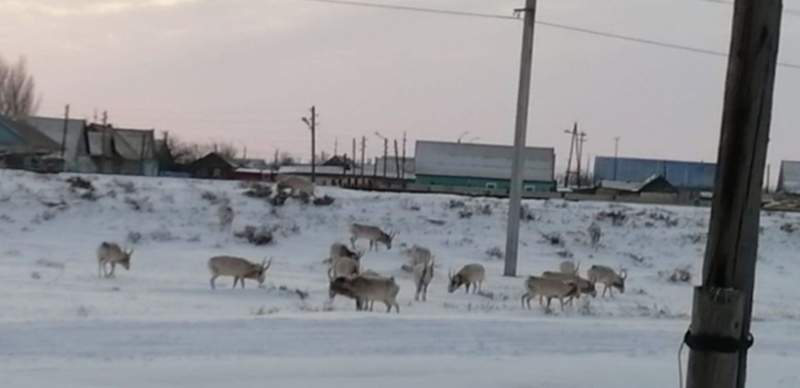
According to the Western regional branch of the State Enterprise “PO Okhotzooprom”, this year 26 cases of saigas entering crops and pastures have been registered (including 10 cases in Zhanibeksky and Taskalinsky districts).
As reported by the head of the West Kazakhstan region agricultural department, Zhasulan Khaliullin, last year information was collected from the districts about lands poisoned by saigas.
— Since there is no methodology for compensation for damage yet, and compensation is not provided, we have not collected such data this year. Currently, the Ministry of Agriculture is developing rules and a methodology for paying compensation. If we talk about paying subsidies for fencing peasant lands, then there are rules for paying subsidies for fencing with an electric fence. But since saigas break through the electric fence, this turned out to be ineffective. For this reason, in the Kaztalovsky and Bokeyordinsky districts, farmers began fencing themselves with hinged nets, through which saigas cannot pass. We demonstrated this practice during the visit of the vice minister. Now the Ministry is working to amend the rules for subsidizing investment in connection with fencing. According to the draft of the Ministry, after the approval of the rules, farmers in the territories where saigas live, fencing their lands with such a net, will be paid a subsidy of 50%, — said Zh. Khaliullin.
What does the Boquejorda Reserve do?
By the Decree of the Government of the Republic of Kazakhstan dated May 25, 2022 No. 330, the Bokeyorda State Nature Reserve and the Ashchyozek State Nature Reserve were created.
According to the data provided by the head of the Bokeyorda reserve, Ulan Mamyrbayev, the reserve includes the lands of the Bokeyorda, Zhanibek, Kaztalovsky and Zhanakalinsky districts with a total area of 343,040.1 hectares. Including the protected area – 181,748 hectares, the buffer zone – 161,282 hectares, the protected area – 124,381 hectares.
In addition, the state nature reserve “Ashchyozek” (314,504.1 hectares) is located in the Kaztalovsky (Koshankolsky and Karaobinsky rural districts) and Zhanibeksky (Zhaksybaysky, Borsinsky, Kamystinsky, Akobinsky rural districts) districts.
As U. Mamyrbayev said, the preservation and protection of saigas is only one of the objectives of the reserve. In addition to saigas, there are other animals, birds, and rare plants listed in the Red Book on the reserve’s territory. The reserve’s employees study and count animals, birds, and plants. For example, during the winter animal census in February of this year, compared to 2023, an increase in the number of species and an increase in their numbers were noted. This is one of the proofs that the reserve’s territory is favorable for animals.
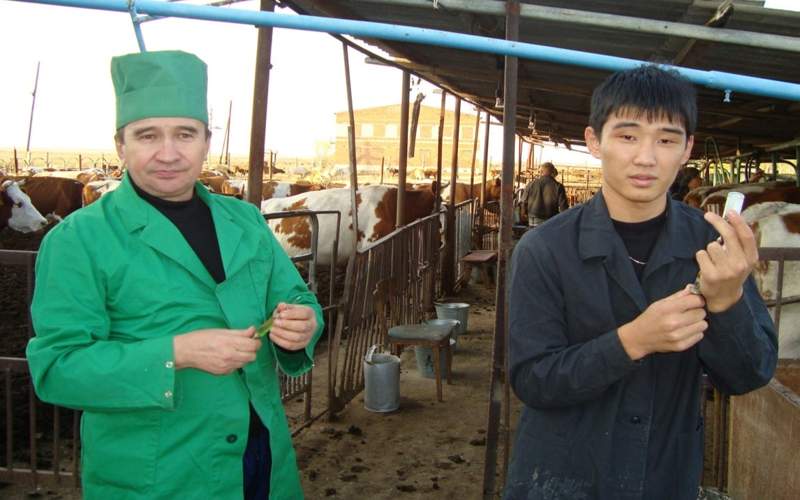
— During lambing and mating seasons, saigas are on the reserve territory. At the same time, it is impossible to block the established old migration routes of saigas, because the reserve territory is not fenced. For their part, the reserve staff, in order to prevent saigas from entering the lands of peasant farms, drives them away and constantly monitors the territory. It is worth noting one more circumstance: the Ministry of Science and Higher Education of the Republic of Kazakhstan, in agreement with the Committee for Forestry and Wildlife of the Ministry of Ecology and Natural Resources, approved a plan for scientific research work of the Bokeyorda State Nature Reserve for 2023-2027. According to the plan, work is being carried out to describe the flora and fauna in the reserve and the Aschyozek sanctuary, to study the ecology and distribution of saigas, — says U. Mamyrbayev.
What information does the Ministry of Ecology have?
According to information received from the Ministry of Ecology and Natural Resources, as a result of comprehensive government protective measures, the number of saigas increased from 21 thousand in 2003 to 2.8 million in 2024, exceeding the highest number during the Soviet period (1.2 million).
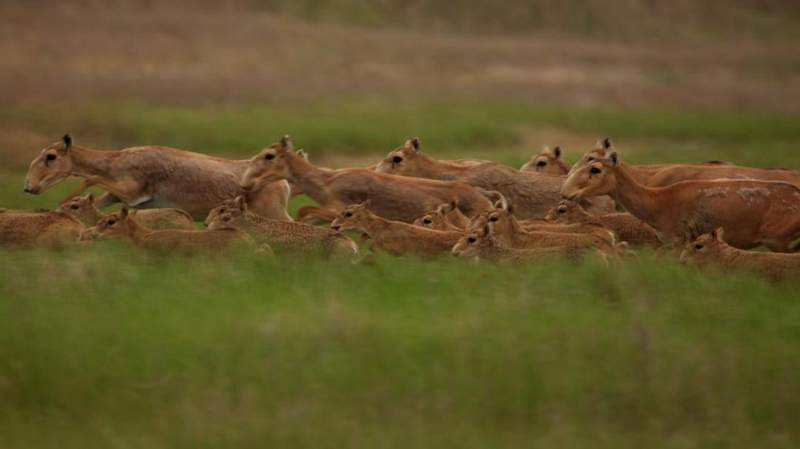
Taking into account the current year’s offspring, the saiga population has reached 4.1 million heads, including 2.3 million in the Ural population, 1.6 million in the Betpak-Dala population, and 92.2 thousand in the Ustyurt population.
Since 2006, the Government of Kazakhstan has expanded specially protected natural areas in the areas where saigas live to more than 5 million hectares. In particular, to preserve the Betpak-Dala population, the state nature reserves “Irgiz-Torgai”, “Altyn Dala”, and in the West Kazakhstan region – “Bokeyorda” were created.
Currently, more than 98% of the world’s saigas live in Kazakhstan.
— On August 16 of this year, a meeting was held between the Minister of Ecology and Natural Resources of the Republic of Kazakhstan and representatives of the Ministry of Natural Resources and Ecology of the Russian Federation, during which the issue of expanding the eco-corridor for the unimpeded passage of saigas into the territory of the neighboring country was discussed. Then an agreement was reached on conducting joint monitoring studies in order to determine the routes of passage of saigas and their concentration, as well as on the creation of a working group to prepare proposals. On October 18, the first meeting of the working group was held in the format of a video conference on the conservation of the transboundary saiga population. The issues of conducting joint research and monitoring, ensuring observation of animals at the state border, their unimpeded and safe passage, preventing damage caused by saigas to agriculture in neighboring regions of Kazakhstan and Russia, and joint actions to preserve the saiga population within the framework of the CITES Convention were considered. Currently, the parties are expecting the approval and signing of the minutes of the meeting of the working group, — the department reported.
The Ministry does not deny that, despite the measures taken, the uncontrolled growth of the saiga population creates a deficit of pastures and watering places, and there are facts of damage to agricultural lands. At the same time, infectious diseases are spreading. For example, in 2015, up to 80% of the Betpak-Dala population died. This can lead to mass infection of farm animals and their death.
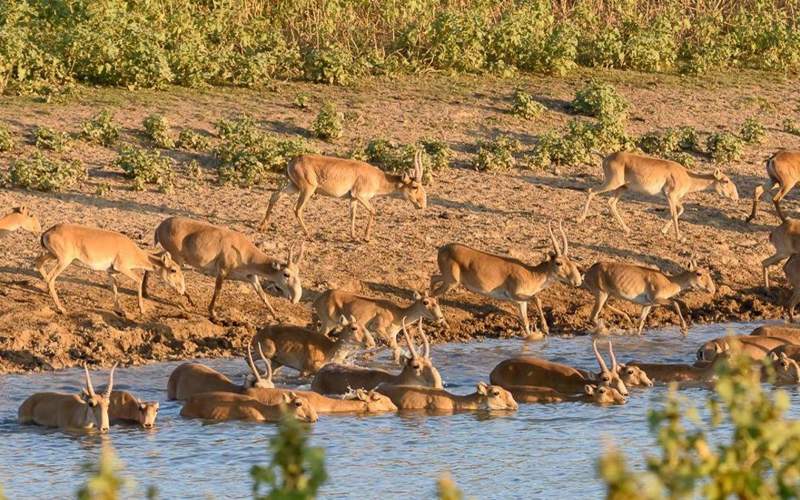
In the regions, operational headquarters have been created to provide assistance to farmers – 175 people and 77 units of equipment have been involved in the protection of agricultural lands on a rotational basis. But it turned out that this is not enough, due to the growth of the saiga population.
— The Ministry of Agriculture has developed a draft order on amendments and additions to the rules for partial compensation of losses incurred by entities in the agro-industrial complex (Order of the Ministry of Agriculture of the Republic of Kazakhstan No. 317 of July 23, 2018), concerning the reduction in the cost of fencing agricultural lands with a hinged mesh. The draft is currently being coordinated with interested government agencies, — the information from the Ministry of Ecology says.
What does the Majilis deputy say?
Majilis deputy Snezhanna Imasheva, originally from the West Kazakhstan region, confirmed that in recent years the saiga population in our country has grown several times. This became possible thanks to government measures to support and protect the population of this species of animals, because the saiga is considered a vulnerable animal.

— In order to prevent the extermination of saigas and the use of their derivatives, in 2019, personal liability for the illegal capture of saigas, their destruction, as well as the appropriation, storage, sale, import and removal, dispatch, transportation of illegally captured saigas or their derivatives, including horns, was introduced into the Criminal Code. Punishment in the form of imprisonment for up to 12 years was provided. There is also a special Law “On the Protection, Reproduction and Use of Wildlife”, which defines general methods for preserving endangered animal species.” Therefore, I believe that new changes are not needed at the legislative level, – says the deputy.
In her opinion, the increase in the number of animals creates a problem for agriculture, this leads to conflicts between them and humans. Therefore, authorized bodies should try to resolve this conflict. There are many ways to resolve such issues in science. For example, according to the deputy, there are various methods, such as creating migration routes, monitoring the habitat, monitoring the number of animals by catching and controlled shooting. But all measures must be justified from scientific, environmental and ethical positions. All these measures regarding saigas do not require changes to legislation. These methods can be regulated in the rules and orders for managing the animal world.
— Another question — I think it is right to compensate farmers for damages. But I also think it is necessary to review the methods of providing land for mowing and sowing. It is impossible to use lands that have historically been migration routes and habitats of saigas in agriculture. This will constantly create conflict between animals and farmers. Compensating farmers for damages caused by such conflicts is not a good idea. As far as I know, the authorized bodies are currently developing measures to allocate money to farmers to protect agricultural lands from saigas, — says S. Imasheva.
Thus, the leaders and specialists, farmers, and the Majilis deputy expressed their opinions on the issue under discussion. Information from the Ministry of Ecology and Natural Resources is provided. And as you can see, a number of pressing issues related to saigas are already being resolved.
Earlier it was reported that farms in the West Kazakhstan region are concerned about the growth of the saiga population. Also, about 4.5 thousand saiga horns were confiscated from offenders in the West Kazakhstan region.
https://www.inform.kz/ru/kak-mozhno-reshit-vopros-s-saygakami-v-zapadno-kazahstanskoy-oblasti-17190c?fbclid=IwY2xjawGwsqFleHRuA2FlbQIxMQABHeLOSReYrV6BGPDD-mOTnUT94yp7zJIuAgdVXBpYIkBwvplulioNUqqrzA_aem_cOmtBawHlfDtoBro7JptjQ&sfnsn=wa

